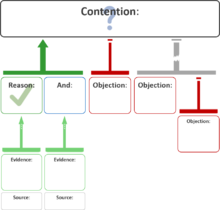
Back خريطة جدلية Arabic نقشه برهان Persian Érvelési térkép Hungarian Аргумент картасы Kazakh د برهان نقشه Pashto/Pushto Mapa de argumentos Portuguese Карта аргументов Russian

 |
| Information mapping |
|---|
| Topics and fields |
| Node–link approaches |
|
| See also |
An argument map or argument diagram is a visual representation of the structure of an argument. An argument map typically includes all the key components of the argument, traditionally called the conclusion and the premises, also called contention and reasons.[1] Argument maps can also show co-premises, objections, counterarguments, rebuttals, inferences, and lemmas. There are different styles of argument map but they are often functionally equivalent and represent an argument's individual claims and the relationships between them.
Argument maps are commonly used in the context of teaching and applying critical thinking.[2] The purpose of mapping is to uncover the logical structure of arguments, identify unstated assumptions, evaluate the support an argument offers for a conclusion, and aid understanding of debates. Argument maps are often designed to support deliberation of issues, ideas and arguments in wicked problems.[3]
An argument map is not to be confused with a concept map or a mind map, two other kinds of node–link diagram which have different constraints on nodes and links.[4]
- ^ Freeman 1991, pp. 49–90
- ^ For example: Davies 2012; Facione 2016, pp. 88–112; Fisher 2004; Kelley 2014, p. 73; Kunsch, Schnarr & van Tyle 2014; Walton 2013, p. 10; van Gelder 2015
- ^ For example: Culmsee & Awati 2013; Hoffmann & Borenstein 2013; Metcalfe & Sastrowardoyo 2013; Ricky Ohl, "Computer supported argument visualisation: modelling in consultative democracy around wicked problems", in Okada, Buckingham Shum & Sherborne 2014, pp. 361–380
- ^ For example: Davies 2010; Hunter 2008; Okada, Buckingham Shum & Sherborne 2014, pp. vii–x, 4